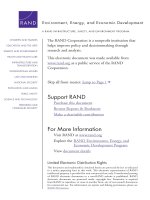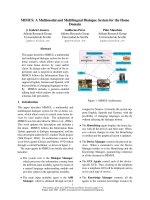A baculovirus cre 1oxp hybrid system for AAVS1 locus directed transgene delivery
Bạn đang xem bản rút gọn của tài liệu. Xem và tải ngay bản đầy đủ của tài liệu tại đây (1.47 MB, 130 trang )
A BACULOVIRUS-CRE/LOXP HYBRID SYSTEM FOR
AAVS1 LOCUS-DIRECTED TRANSGENE DELIVERY
CHRISHAN J. A. RAMACHANDRA
NATIONAL UNIVERSITY OF SINGAPORE
2011
A Baculovirus-Cre/loxP Hybrid System for AAVS1 Locus-
Directed Transgene Delivery
Chrishan J. A. Ramachandra
(B.Sc. (Hons.), Queen Mary, University of London)
A Thesis Submitted
For the Degree of Doctor of Philosophy
Department of Biological Sciences
National University of Singapore
2011
i
Acknowledgments
Foremost, I would like to express my sincere gratitude to my supervisor Associate
Prof. Wang Shu for the continuous support and guidance throughout my candidature.
His ready knowledge and encouragement whilst still allowing me to carry out my
research in an independent manner made this study an enlightening and enjoyable
process.
I would like to thank my fellow graduate student Mohammad Shahbazi for his
wonderful work ethic and thought provoking conversations which made long days in
the lab a pleasant experience. I thank my fellow lab mates Timothy Kwang, Lam
Dang Hoang and Yovita Ida Purwanti for all the fun and laughter we have had over
the years.
My sincere thanks to Dr. Seong Loong Lo and to all other members of the lab who
have supported me on my research journey.
I express my heartfelt gratitude to my fiancée Kathleen Fernando for her support and
understanding at times when my only focus was on the screen in front of me.
Last but not least I would like to acknowledge the Institute of Bioengineering and
Nanotechnology for providing the opportunity to conduct my research in a renowned
institute as well as the National University of Singapore for offering my Ph.D.
candidature and research scholarship.
ii
Publication
The contents of this thesis are based upon the following publication.
Ramachandra, C.J., et al., Efficient recombinase-mediated cassette exchange at the
AAVS1 locus in human embryonic stem cells using baculoviral vectors. Nucleic Acids
Res, 2011. 39(16): p. e107.
iii
Table of Contents
Summary viii
List of Tables x
List of Figures xi
List of Abbreviations xiii
1. An Introduction to Gene Therapy 1
1.1 Genetic Modification Procedures 1
1.1.1 Gene Augmentation 1
1.1.2 Gene Knockdown 2
1.1.3 Gene Editing 3
1.2 Viral Vectors and Transgene Delivery Systems 4
1.2.1 Non-Viral Gene Delivery 4
1.2.1.1 Physical Non-Viral Gene Delivery 5
1.2.1.2 Chemical Non-Viral Gene Delivery 6
1.2.2 Viral Gene Delivery 8
1.3 Challenges Associated with Gene Therapy 10
1.3.1 Insertional Mutagenesis 10
1.3.2 Transgene Silencing 11
1.4 Transgene Delivery within a Pre-Defined Genomic Locus 12
iv
1.4.1 Adeno-Associated Virus Integration Site-1 12
1.4.2 AAV2 Technology 13
1.4.3 Zinc-Finger Nucleases 13
1.4.4 Transcription Activator-Like Effector Nucleases 14
2. Aim of Study 16
3. Materials and Methodology 20
3.1 Vector Construction and Baculovirus Propagation 20
3.1.1 Plasmid Construction 20
3.1.2 Recombinant Baculoviral Vector Construction 21
3.1.3 Baculovirus Propagation 22
3.2 Genetic Modification of Human Cell Lines 23
3.2.1 HeLa Cells 23
3.2.2 Human Embryonic Stem Cells 24
3.3 Detection of AAVS1 Modifications 26
3.3.1 PCR Genotyping 26
3.3.2 Southern Blot Analysis 26
3.4 Human Embryonic Stem Cell Differentiation 27
3.4.1 Embryoid Body Derivation 27
3.4.2 Neurosphere, Glial Cell and Neuron Derivation 27
v
3.4.3 Mesenchymal Stem Cell Derivation 28
3.4.4 Dendritic Cell Derivation 28
3.5 Characterization of Human Embryonic Stem Cells and Differentiated Cell
Progenies 30
3.5.1 Immunostaining 30
3.5.2 RT-PCR Analysis 31
3.5.3 Flow Cytometric Analysis 31
3.6 BV-RMCE Functional Studies 32
3.6.1 In Vitro Tumor Killing Assay 32
3.6.2 In Vitro Migration Assay 32
4. Experimental Results 34
4.1 Homologous Recombination at the AAVS1 34
4.1.1 Generation of a loxP-HeLa Cell Line 34
4.1.2 Generation of a loxP-hESC Line 35
4.2 Cre Recombinase-Mediated Cassette Exchange Using Baculoviral Vectors 42
4.2.1 Generation of Transgenic HeLa Cells 42
4.2.2 Generation of Transgenic hESCs 43
4.3 AAVS1-Directed Transgene Integration Results in Persistent Expression 50
4.3.1 Expression Analysis in Transgenic HeLa Cells 50
4.3.2 Expression Analysis in Transgenic hESCs 50
vi
4.4 AAVS1-Directed Transgene Integration Does Not Affect hESC Pluripotency 54
4.4.1 Phenotype Comparison of Genetically Modified hESCs 54
4.4.2 Confirmation of Pluripotency in Transgenic hESCs 54
4.5 Persistent Transgene Expression Maintained Following hESC Differentiation 58
4.5.1 Transgenic Neural Stem Cell Derivation and Terminal Differentiation 58
4.5.2 Transgenic Mesenchymal Stem Cell Derivation 59
4.5.3 Transgenic Dendritic Cell Derivation 59
4.6 Glioma Gene Therapy Potential of BV-RMCE 64
4.6.1 Generation of Transgenic hESCs 64
4.6.2 Gap Junction-Mediated Bystander Killing Effect of Transgenic NSCs 65
4.6.3 Tumor Migratory Properties of Transgenic NSCs 65
4.7 Zinc-Finger Nuclease-Mediated Homologous Recombination at the AAVS1
Using Baculoviral Vectors 70
4.7.1 Genetic Modification in the Absence of Drug Selection 71
4.7.2 Transgene Expression Analysis 71
5. Discussion 74
5.1 Gene Targeting by Homologous Recombination 74
5.1.1 Cell Type Influences Recombination Frequency 75
5.1.2 Targeting Construct Influences Recombination Frequency 76
5.2 Cre/loxP Recombinase System – A Versatile Tool for Genome Modification 78
vii
5.2.1 Mutated loxP Sites Enhance Site-Specific Transgene Integration
Efficiency 78
5.2.2 MOI of Transgene Donor Influences RMCE Efficiency in HeLa Cells 79
5.2.3 Baculovirus Transduction Mediates Efficient RMCE in hESCs 80
5.3 Therapeutic Gene Delivery by Baculoviral Vectors 82
5.3.1 Baculoviral Vectors Mediate Efficient Gene Delivery in hESCs 82
5.3.2 Baculovirus and Immunotoxicity 83
5.4 BV-RMCE in Stem Cell Research 84
5.4.1 Generation of Transgenic Cells for Ex Vivo Gene Therapy and
Regenerative Medicine 84
5.4.2 Understanding Developmental Biology 85
5.4.3 Screening of Drugs and Toxins for Therapeutic Applications 86
5.4.4 Generation of iPS Cells for Regenerative Medicine 86
5.4.5 Generation of Transgenic iPS Cell-Derived Progenies for Ex Vivo Gene
Therapy 87
5.4.6 Adeno-Associated Virus Infection of Transgenic Cells 88
6. Conclusion 90
Bibliography 92
Appendix 109
viii
Summary
Gene therapy is a promising application for the treatment of patients with inherited or
acquired diseases. It can be performed either in vivo or ex vivo and the principle
concept involved is the introduction of exogenous genetic material into a patient. In
ex vivo gene therapy, therapeutic genes are delivered into transplantable cells where
they must maintain persistent expression as failure to do so would result in a loss of
therapeutic benefits. Transgene integration within the host genome is the most
common way to induce persistent expression, however, most if not all approaches
taken to achieve this feat are plagued by technical issues and safety concerns,
namely insertional mutagenesis and transgene silencing. Hence, it is imperative to
find an approach that induces persistent transgene expression without compromising
genomic stability. Furthermore, it is necessary to identify genomic sites that are
resistant to epigenetic silencing phenomena and upon disruption would not be
detrimental to the host cell. The adeno-associated integration site-1 locus (AAVS1)
on human chromosome 19 is one such site and is therefore regarded as a safe
harbour for the integration of therapeutic genes.
This study focuses on targeting the AAVS1 in human embryonic stem cells (hESCs)
and HeLa cells via a novel approach. First, through conventional homologous
recombination a floxed neomycin resistance marker was introduced into this locus. It
was then replaced (exchanged) with a gene of interest (EGFP or HSVtk) using two
baculoviral vectors; one expressing Cre recombinase and the other the transgene
donor. Through this baculoviral vector-mediated Cre recombinase-mediated cassette
exchange (BV-RMCE) technique significantly high transgene integration efficiencies
were achieved at the AAVS1, allowing for the generation of transgenic hESCs and
HeLa cells.
ix
To ensure that the AAVS1-integrated transgene was resistant to epigenetic silencing
phenomena, EGFP-hESCs and EGFP-HeLa cells generated through BV-RMCE were
expanded for 20 and 24 passages respectively in the absence of drug selection.
While both these transgenic cell lines (underwent site-specific integration) displayed
no evidence of silencing, hESC lines that underwent random integration displayed a
clear loss of EGFP expression within 7 passages.
Following genetic modification, EGFP-hESCs continued to express stem cell markers
but failed to express lineage markers; revealing that the two-step genetic modification
process incorporated in BV-RMCE impacted neither the phenotype nor the
pluripotency of these cells. EGFP-hESCs were differentiated into neural stem cells,
mesenchymal stem cells and dendritic cells. The ability to differentiate into
ectodermal and mesodermal lineages further demonstrated that the differential
potential of these transgenic cells remained intact. Like EGFP-hESCs, the
differentiated progenies too displayed no loss of transgene expression upon
expansion. These results confirmed that transgene integration within the AAVS1 did
not lead to genomic instability and that transcriptional competence was still
maintained across diverse cell types following hESC differentiation.
The study was concluded by demonstrating the clinical potential of BV-RMCE. The
HSVtk suicide gene was integrated within the AAVS1 and the result was TK
expressing neural stem cells with the capability of killing U87 glioma cells with high
efficacy in the presence of GCV. These cells also displayed tumor tropism;
confirming that they were functionally adequate for glioma therapy. The results
obtained throughout the entire study and the use of this technology in the field of
stem cell research is also discussed.
x
List of Tables
Table 4.1: Efficiency of AAVS1 targeting in HeLa cells by homologous
recombination 39
Table 4.2: Efficiencies of AAVS1 targeting in hESCs by homologous
recombination 41
Table 4.3: Efficiencies of EGFP integration within the AAVS1 in HeLa cells
by BV-RMCE 47
Table 4.4: Efficiencies of EGFP integration within the AAVS1 in hESCs
by BV-RMCE 49
Table 4.5: Efficiency of HSVtk integration within the AAVS1 in hESCs
by BV-RMCE 67
xi
List of Figures
Figure 2.1: Schematic representation of BV-RMCE 19
Figure 4.1: Schematic representations for detection of homologous
recombination 37
Figure 4.2: Detection of homologous recombination in HeLa cells 38
Figure 4.3: Detection of homologous recombination in hESCs 40
Figure 4.4: Schematic representation for detection of BV-RMCE 45
Figure 4.5: Detection of RMCE in HeLa cells 46
Figure 4.6: Detection of RMCE in hESCs 48
Figure 4.7: Persistent transgene expression in EGFP-HeLa cells 52
Figure 4.8: Persistent transgene expression in EGFP-hESCs 53
Figure 4.9: Detection of hESC surface antigens 56
Figure 4.10: Confirmation of EGFP-hESC pluripotency 57
Figure 4.11: Derivation, characterization and terminal differentiation of
EGFP-NSCs 61
Figure 4.12: Derivation and characterization of EGFP-MSCs 62
Figure 4.13: Derivation and characterization of EGFP-DCs 63
Figure 4.14: Detection of RMCE (HSVtk) in hESCs and transgene expression
analysis in derived cells 66
Figure 4.15: Tumor killing effect of TK-NSCs 68
Figure 4.16: Tumor tropism of TK-NSCs 69
xii
Figure 4.17: Detection of ZFN-mediated homologous recombination in HeLa
cells 72
Figure 4.18: ZFN-induced persistent transgene expression in HeLa cells 73
xiii
List of Abbreviations
AAV Adeno-Associated Virus
AAVS1 Adeno-Associated Virus Integration Site-1
AFP Alpha-Fetoprotein
AIDS Acquired Immunodeficiency Syndrome
ALD X-linked Adrenoleukodystrophy
APC Allophycocyanin
ASC Adult Stem Cell
BDNF Brain-Derived Neurotrophic Factor
bFGF Basic Fibroblast Growth Factor
BSA Bovine Serum Albumin
BV Baculovirus
CCR5 C-C Chemokine Receptor-5
CD Cluster of Differentiation
c-Myc Myelocytomatosis Oncogene
DC Dendritic Cell
dcAMP Derivative of Cyclic Adenosine Monophosphate
DIG Digoxigenin
DMEM Dulbecco's Modified Eagle Medium
DMEM/F12 DMEM: Nutrient Mixture F-12
xiv
DNA Deoxyribonucleic Acid
DSB Double-Strand Break
EF1α Elongation Factor 1 Alpha
EGF Epidermal Growth Factor
EGFP Enhanced Green Fluorescent Protein
FACS Fluorescence-Activated Cell Sorting
FBS Fetal Bovine Serum
Fezf2 FEZ Family Zinc Finger-2
FGF8 Fibroblast Growth Factor-8
FITC Fluorescein Isothiocyanate
Floxed Flanked by loxP sites
GCV Ganciclovir
GDNF Glial Cell-Derived Neurotrophic Factor
GFAP Glial Fibrillary Acidic Protein
GMCSF Granulocyte Macrophage Colony Stimulating Factor
hESC Human Embryonic Stem Cell
HIV Human Immunodeficiency Virus
HLA- DRQP Human Leukocyte Antigen DR/DQ/DP
HLA-ABC Human Leukocyte Antigen A/B/C
HPC Hematopoietic Progenitor Cell
xv
HPRT1 Hypoxanthine Phosphoribosyltransferase-1
HSVtk Herpes Simplex Virus Thymidine Kinase
IL Interleukin
IL2RG Interleukin-2 Receptor Gamma
iPS cell Induced Pluripotent Stem Cell
IRES Internal Ribosomal Entry Site
Klf4 Krueppel-Like Factor 4
LCA Leber's Congenital Amaurosis
LMO2 LIM domain Only 2
LPL Lipoprotein Lipase
mESC Mouse Embryonic Stem Cell
MHC Major Histocompatability Antigens
mIPS cell Mouse Induced Pluripotent Stem Cell
MOI Multiplicity of Infection
MSC Mesenchymal Stem Cell
MTG Monothioglycerol
NaCl Sodium Chloride
NaOH Sodium Hydroxide
NEAA Non-Essential Amino Acids
NK cell Natural Killer Cell
xvi
NSC Neural Stem Cell
Oct-3/4 Octamer-Binding Transcription Factor-3/4
Olig2 Oligodendrocyte Lineage Transcription Factor-2
ORF Open Reading Frame
OTC Ornithine Transcarbmaylase
Pax6 Paired Box Gene-6
PBS Phosphate buffered saline
PCR Polymerase Chain Reaction
PE Phycoerythrin
PFA Paraformaldehyde
PGK Phosphoglycerate Kinase
pHEMA Poly 2-Hydroxyethylmethacrylate
PI Propidium Iodide
POU5F1 POU Class 5 Homeobox-1
PPP1R12C Protein Phosphatase 1, Regulatory Subunit 12C
PS Penicillin-Streptomycin
RMCE Recombinase-Mediated Cassette Exchange
RNA Ribonucleic Acid
RT-PCR Reverse Transcription Polymerase Chain Reaction
SCID-X1 Severe Combined Immunodefiniciency-X1
xvii
SDS Sodium Dodecyl Sulphate
SFEM Serum-Free Expansion Medium
SFM Serum-Free Medium
Shh Sonic Hedgehog
SOX2 Sex Determining Region Y-Box-2
SSC Saline-Sodium Citrate
SSEA-4 Stage-Specific Embryonic Antigen-4
SV40 Simian Virus 40
TALEN Transcription Activator-Like Effector Nuclease
TGF-β3 Transforming Growth Factor Beta-3
TR Texas Red
Tra Tumor Rejection Antigen
TRITC Tetramethyl Rhodamine Isothiocyanate
WAS Wiskott-Aldrich Syndrome
X-CGD X-linked Chronic Granulomatous Disease
ZFN Zinc-Finger Nuclease
α-MEM Minimum Essential Medium Alpha
1
1. An Introduction to Gene Therapy
1.1 Genetic Modification Procedures
In today’s world of scientific advancement, gene therapy is being looked upon more
favourably with regard to its application in the treatment of individuals with inherited
or acquired diseases. In vivo gene therapy is defined as the introduction of
exogenous genetic material into a patient and ex vivo therapy is defined as the
transplantation of genetically modified autologous or allogenic cells or tissues.
The principle concept surrounding gene therapy is the introduction of genetic
modifications either in vivo or ex vivo which include (i) gene augmentation – the
addition of genes, (ii) gene knockdown – the silencing of genes and (iii) gene editing
– the alteration of genes.
1.1.1 Gene Augmentation
This is the most common form of genetic modification and is utilised in therapeutic
applications for the treatment of individuals with metabolic deficiencies or cancers
resulting from a defective gene. Gene augmentation aims at introducing a healthy
gene (a transgene) into a patient thus facilitating the expression of a protein which
was otherwise lacking. The process does not replace the defective gene and is
hence referred to as gene augmentation since multiple copies of the gene, both
defective and healthy exist in the patient.
Studies have revealed that a defect in the p53 tumor suppressor gene is responsible
for many human cancers [1]. Therefore, by intraperitoneal infusion of an adenoviral
vector expressing a wild-type p53 gene, improved survival times were achieved in
patients with advanced ovarian cancer [2, 3]. Furthermore, it has been revealed that
a defect in the IL2RG gene hinders the proliferation and differentiation of
2
hematopoietic progenitor cells (HPCs) and is thus responsible for a severely
compromised immune system [4]. Therefore, by transplanting autologous HPCs that
were modified with a retroviral vector expressing a wild-type IL2RG gene, patients
with SCID-X1 were successfully able to produce functional T-cells and natural killer
(NK) cells [5]. Both these examples highlight how gene augmentation has been
successfully utilised in both in vivo and ex vivo gene therapy.
1.1.2 Gene Knockdown
Gene knockdown is considered the opposite of gene augmentation as it aims to
reduce or completely silence the expression of a gene. This is achieved by utilising
RNA interference (RNAi). RNAi is a naturally occurring post-transcriptional gene
regulatory process that uses small non-coding RNA molecules, namely short
interfering RNAs (siRNAs) and micro RNAs (miRNAs). siRNAs and miRNAs defer
from one another in that the former molecule’s sequence is directly complementary to
that of its target mRNA and thus induces silencing via a cleavage-dependent
pathway. miRNAs however contain mismatches in their sequences and thus target a
range of mRNAs where they induce silencing by either a cleavage or translational
repression mechanism [6]. Short hairpin RNAs (shRNAs), a type of RNA molecule
that mimics the mechanism of miRNAs can also induce post-transcriptional silencing.
Studies have revealed that miR-26a consists of anti-proliferation and apoptotic
properties and is thus down-regulated in certain tumors [7]. Therefore, by systemic
administration of an adeno-associated viral (AAV) vector expressing miR-26a, tumor
suppression was achieved in a mouse liver cancer model [8]. Furthermore, it has
been revealed that the CCR5 gene which encodes for a cell-surface receptor is
responsible for HIV infection and replication [9, 10]. Therefore, by transplanting
autologous HPCs that were modified with a lentiviral vector expressing small non-
3
coding RNAs directed against the CCR5 gene, it was found that these cells conferred
a selective advantage which led to the suppression of HIV in patients with AIDS-
related lymphoma [11]. These examples highlight the therapeutic potential of RNAi
molecules.
1.1.3 Gene Editing
When compared with gene augmentation and gene knockdown, gene editing is a
completely different form of genetic modification. Rather than use a transgene to
enhance gene expression or a RNAi molecule to silence gene expression, this
process aims at altering the gene itself by utilising the cell’s very own homologous
recombination mechanism.
Studies have revealed that a mutation in the HPRT1 gene results in Lesch-Nyhan
disease [12]. By utilising conventional homologous recombination, this mutation was
successfully corrected in mouse HPCs [13].Furthermore, as discussed previously, a
mutation in the IL2RG gene results in SCID-X1. By using zinc-finger nucleases
(ZFNs) this mutation too was successfully corrected in human T-cells via a
homology-directed repair mechanism [14].
As discussed previously the CCR5 gene is responsible for HIV infection and
replication. Therefore, by using ZFNs directed against the CCR5 gene in human T-
cells and HPCs, HIV suppression was achieved in a humanized mouse model [15,
16]. The disruption of the gene was attributed to a non-homologous end-joining
mechanism. These examples highlight as to how gene editing can be utilised in
therapeutic applications either by the correction of mutations found in defective
genes or by the disruption of healthy genes.
4
1.2 Viral Vectors and Transgene Delivery Systems
Having focussed on the various forms of genetic modification we turn our attention as
to how these modifications are made possible. For gene augmentation, gene
knockdown and gene editing to be successful, a transgene (therapeutic gene or
RNAi molecule) must be introduced into a patient via the use of viral vectors or non-
viral delivery systems. This section focuses on the various types of gene delivery
systems and provides examples of their therapeutic potential and clinical success.
1.2.1 Non-Viral Gene Delivery
This approach utilises either physical or chemical systems to deliver a gene
expressing plasmid into a patient. There are several advantages associated with
plasmids, the most important being their lack of viral components. Furthermore, the
lack of a size constraint which enables these systems to deliver unlimited amounts of
DNA together with their inability to stimulate any pre-existing antigen-dependent
immunity supports their use in therapeutic applications. By being able to successfully
deliver genes in vitro, non-viral systems have demonstrated their ex vivo gene
therapy potential [17].
However, one major drawback associated with these systems is their inability to
efficiently deliver genes in vivo. Furthermore, when considering their use in ex vivo
gene therapy, once delivered into a cell, plasmids exist episomally and thus provide
transient transgene expression which would lead to the loss of therapeutic benefits
over time. But, when compared with their viral counterparts, plasmids are considered
as a safer alternative and hence efforts are being made to enhance the efficacy of
non-viral gene delivery systems in vivo.
5
1.2.1.1 Physical Non-Viral Gene Delivery
In this approach a physical force is utilised to temporarily disrupt the cell membrane
and thus facilitates gene uptake. Physical forces currently being studied include DNA
injection, hydrodynamic gene transfer, biolistic particle delivery, electroporation, and
sonoporation.
DNA injection is the simplest physical non-viral approach that aims at delivering a
gene directly into a patient’s tissues. It has been utilised in the treatment of patients
with chronic myocardial ischemia [18]. Although considered a safe approach, DNA
injection can lead to localised pain, oedema or bleeding at the site of injection.
Hydrodynamic gene transfer is similar to DNA injection but defers from the fact that
it involves the injection of large amounts of DNA within a short period of time. It has
the potential to be utilised for the delivery of genes into the liver [19]. However, the
requirement for large injection volumes that is beyond the acceptable level of a
patient make hydrodynamic gene transfer a risky option.
Biolistic particle delivery utilises a gene gun that enables tissue bombardment with
DNA-coated heavy metal particles. Tungsten, gold and silver are some of the metals
used in this approach. The efficiency of gene delivery and tissue penetration as well
as the degree of tissue injury is determined by multiple parameters such as gas
pressure, the size of the particle and the dosing frequency. Biolistic particle delivery
has the potential to be utilised in the treatment of diabetes [20]. The cytotoxic effects
caused by tungsten and the expenses that surround gold and silver are some of the
disadvantages associated with this approach.
Electroporation utilises an electric field to alter cell membrane permeability, and
thus facilitates gene uptake. In this approach, the tissue is first injected with a
plasmid followed by exposure to electric pulses. Electroporation has the potential to
be utilised in localised gene therapy where it is necessary to deliver genes into a
6
specific location within a certain tissue and also in the treatment of diabetes [21, 22].
However, the limited accessibility of the electrodes to the internal organs hinders its
use in therapeutic applications.
Sonoporation utilises ultrasound waves together with a contrast agent or micro-
bubble to alter the structure of a cell membrane, and thus facilitates gene uptake. It
has the potential to be utilised for the delivery of genes into the heart and also in the
treatment of bone deformities (osteogenesis) [23, 24]. Unlike electroporation,
sonoporation can reach the internal organs; however, the use of plasmid DNA leads
to transient gene expression which is futile in applications where long-term
therapeutic benefits are required.
1.2.1.2 Chemical Non-Viral Gene Delivery
This approach uses a chemical compound that can form complexes with naked DNA
molecules by electrostatic interactions. These complexes protect the DNA molecule
and facilitate its cellular uptake. Chemical compound currently being studied include
cationic lipids, cationic polymers and inorganic nano-particles.
Cationic lipids also referred to as liposomes contain a positively charged hydrophilic
head and hydrophobic tail which are connected by a linker structure. Owing to its
positive charge, the hydrophilic head can bind to negatively charged DNA molecules
and protect them against nucleases. This liposome-DNA complex is referred to as a
lipoplex. Cationic lipids also facilitate the cellular uptake of DNA molecules by
interacting with the negatively charged cell membrane. The efficiency of gene
delivery as well as the degree of cytotoxicity and immunogenicity is determined by
multiple parameters such as the molecular structure, the charge ratio and the co-lipid
properties. These compounds have the potential to be utilised in the treatment of
prostate cancer and influenza A infection [25, 26]. Furthermore, they are inexpensive









